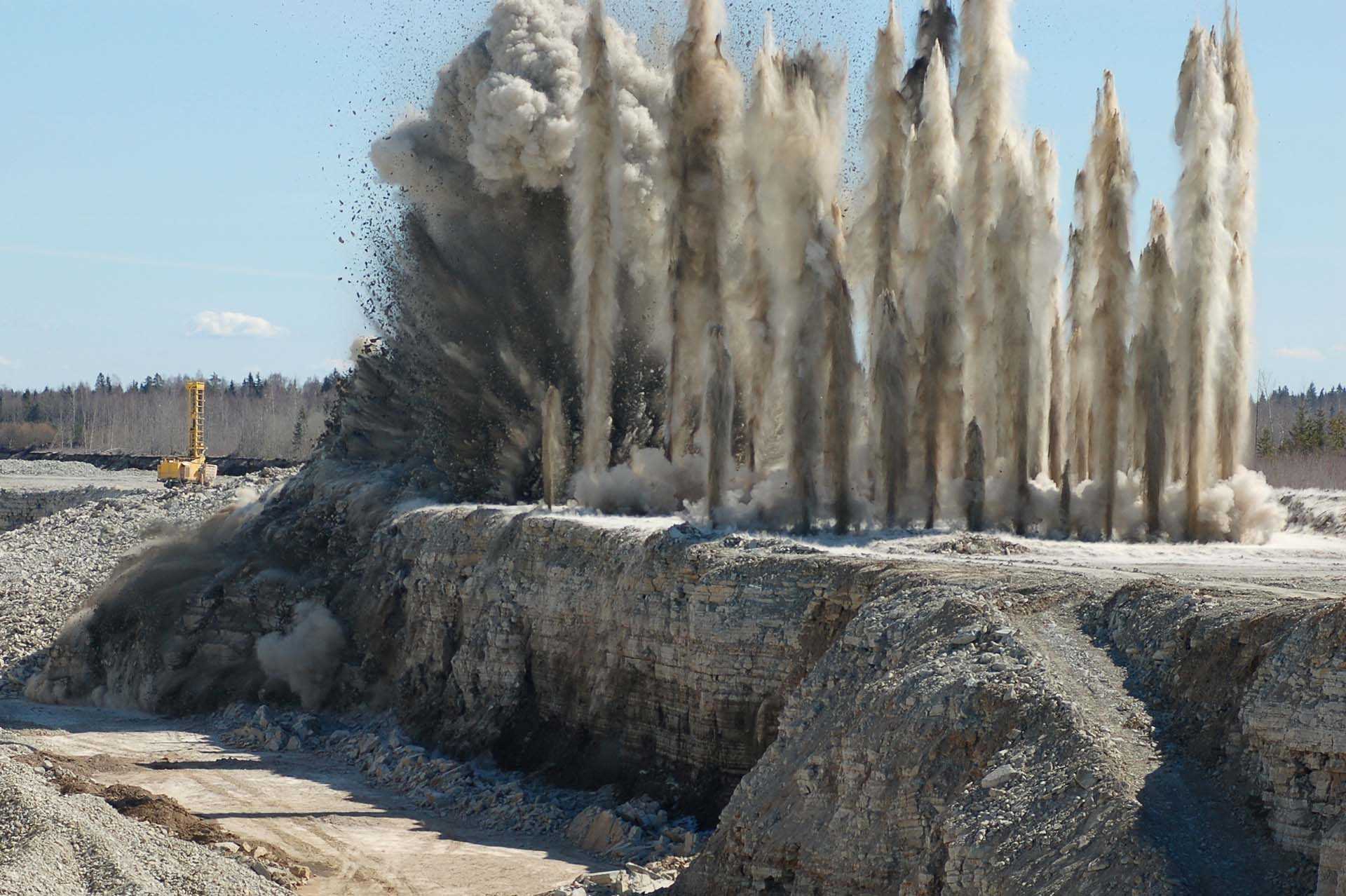EnviroMail 49 Canada - Acid-Base Accounting Tests to Predict Acid Rock Drainage for Mining, Major Projects, & Protocol 19
The need to test materials for Metal Leaching (ML) and Acid Rock Drainage (ARD) potential is expanding beyond the mining sector to include major engineering projects and the relocation of soils and rock waste from quarried materials, rock cuts, and excavations.

Growing Need for ML/ARD Testing
In Canada and the US, environmental mining regulators require ML/ARD prediction testing on materials that will be exposed during a mine’s lifecycle. Many projects outside the mining sector now also require ML/ARD testing and management, such as the Trans Mountain Pipeline Expansion and the BC Hydro Site C Dam. In 2013, the BC Ministry of Transportation and Infrastructure released technical guidance expanding their policy and requirements for ML/ARD prediction for quarries, rock cuts, stockpiled rock, and talus materials. In January 2023, the BC Ministry of Environment and Climate Change Strategy incorporated ML/ARD testing into Protocol 19 for soil relocation of quarried material derived from mined or crushed bedrock.
Overview of ML/ARD & ABA Tests
Acid Rock Drainage (ARD) occurs when sulfide materials such as pyrite, pyrrhotite, and chalcopyrite are exposed to oxidizing conditions (typically through mining or excavation), producing sulfuric acid. Acidic drainage water can cause environmental harm due to leaching of toxic heavy metals, or impacts of low pH to ecosystems and aquatic life. The presence of sulfide minerals alone is insufficient to predict ARD because some sulfide minerals are non-reactive, and because neutralizing minerals such as calcite or dolomite can mitigate acid generation and metal run-off.
ML/ARD tests are kinetic (long-term) and static (short-term) tests that assess physical and chemical properties of material (normally crushed rock).
Kinetic tests like humidity cells simulate consistent weathering and evaluate if a sample will become acid generating over time. Refer to EnviroMail 13 for details about humidity cell methods, shake flask testing, and other advanced techniques for evaluation and prediction of ARD impacts.
Acid-Base Accounting tests are static tests which measure metal concentrations, sulfur species, Maximum Potential Acidity (MPA), and Neutralization Potential (NP). Net Neutralization Potential (NNP) is then calculated as NP minus MPA, which can be positive (net acid neutralizing), zero (neither neutralizing or acid producing), or negative (net acid producing). MPA is also referred to as Acid Production Potential (AP). All of these values are reported in units of kg CaCO3 per tonne. Several methods for determining NNP have been published by different research groups, and regulators in different jurisdictions may require different versions of these methods.
ALS offers a wide range of methods for ABA estimation, including Sobek, Modified Sobek, Siderite Correction, Modified Neutralization Potential (MEND), and others. Brief descriptions of these methods follow.
Sobek Method (Default NP/MPA Test)
For calculation of MPA, the Sobek Method (1978) assumes all sulfur in a sample is present as pyrite and that all pyrite will be the oxidized to sulfuric acid. This is the most conservative MPA calculation, and is intended for materials such as mine tailings that are known to contain sulfide minerals. Each mole of sulfur produces two moles of acid, which requires one mole of calcium carbonate to be neutralized. For calculation of NP, a known amount of hydrochloric acid (HCl) is added to the sample prior to brief reaction at near-boiling temperature;; when the reaction is complete it is titrated with sodium hydroxide to pH 7.
Modified Sobek Method (Option M)
The Modified Sobek method bases the MPA on sulfide sulfur instead of total sulfur, which avoids overestimation of the MPA for samples where a significant fraction of total sulfur is comprised of sulfates (e.g. gypsum and barite), which do not contribute to acid generation. The Modified Sobek Method (Lawrence and Wang, 1997) uses HCl for the NP reaction but the titration endpoint is 8.3 instead of 7.0, and the reaction temperature is ~25-30° C (ambient), instead of slightly below boiling. The reaction proceeds for 24 hours prior to titration. The Modified Sobek Method is most appropriate for investigation of materials that are not known or expected to contain high levels of sulfide minerals
MEND Method (Option B)
The MEND method uses the modified neutralization potential as outlined in MEND (1991). A portion of pulverized sample is treated with an appropriate amount of HCl at ambient temperature. The pH of the slurry is checked twice throughout the 24-hour reaction period to ensure HCl levels are sufficient for the reaction to proceed at all times, and the resulting slurry is titrated with sodium hydroxide to an endpoint of pH 8.3. The measured neutralization potential is reported as calcium carbonate equivalents, and the total sulfur measurement is used for the calculation of MPA.

Siderite Correction (Option S)
All of the standard NP measurements can be overestimated when siderite (FeCO3) is present (Meek, 1981), because there is insufficient time during the test for oxidation of ferrous iron and subsequent precipitation of ferric hydroxide. When ferric hydroxide precipitates, an equal amount of acid is generated, resulting in a net zero NP for siderite. As only the base generating part of the reaction is counted, erroneously high NP values can be reported for samples containing siderite (Fey, 2003). If siderite is expected to be present, this bias can be corrected by adding hydrogen peroxide (H2O2) to the filtrate of the hydrochloric acid (HCl) digested sample to oxidize ferrous iron to ferric iron before back-titration. Because the resulting ferric iron is precipitated as iron hydroxide [Fe(OH)3] upon titration, the solution yields a more accurate NP value for siderite-bearing material.
Paste pH
Paste pH is measured by pH electrode on a portion of sample which has been mixed with deionized water to form a paste. The sample pH indicates if there is readily available acidity or alkalinity in the sample material (MEND 1991). A pH below 5 indicates acidity, which may suggest prior acid generation.
Total Sulfur
Total sulfur is measured by heating a sample in a stream of oxygen to > 1000°C in an induction furnace. All sulfur species are oxidized by combustion to sulfur dioxide, which is measured by infrared detection.
Sulfate Sulfur
All ABA methods estimate the total amount of sulfur present in a sample, and most assume all sulfur originates from sulfide minerals. If likely to be present, sulfates can be measured directly to avoid overestimates of acid production potential, because most sulfate minerals do not cause acid generation. Sulfate sulfur is measured after leaching with either HCl or sodium carbonate. The HCl leach captures most sulfate species, excluding barite and celestite; if either of these minerals is likely to be present, the carbonate leach method is recommended. If both the HCl and carbonate leachate methods are used, it is possible to estimate the proportions of the major sulfate species present (e.g. gypsum vs. barite). Sulfate analysis is gravimetric after filtration of the leachate and precipitation of barium sulfate with BaCl2. Sulfate Sulfur results are reported as percent of total sulfur in the sample.
Sulfide Sulfur (Analyzed)
A sub-sample of pulverized material is leached in warm sodium carbonate (Na2CO3) solution to solubilize and remove sulfate, and the remaining material is tested for Sulfide Sulfur by Leco combustion analyzer with IR detection.
Inorganic Carbon (Carbonate)
Many ABA packages include measurement of inorganic carbon associated with carbonate minerals, which is determined by reaction of a sample with acid in a heated container followed by measurement of evolved CO2.
Sample Submission Requirements
ABA and other ARD-related tests can be performed on a variety of rock sample types, including waste rock, mine tailings, drill chips, grab samples, diamond cores, etc. A minimum of 500 grams of sample is required for ABA tests, and submissions must specify exact method requirements (e.g. Sobek, Modified Sobek, MEND, Siderite Correction, etc.). Humidity cell tests require submission of approximately 2 kg of rock sample. Shake Flask and Four-Acid Metals methods require an additional 500 grams of combined sample. Samples are crushed and pulverized to the appropriate particle size required to process the requested methods. Refer to Table 1 for a complete summary of ABA test options available.
| ABA-PKG01 | ABA-PKG02 | ABA-PKG03 | ABA-PKG04 | ABA-PKG05 | BC251 | |
| NP/MPA Options (Default = Sobek) → | (M/S)2 | (M/S)2 | (M/S)2 | (M/S)2 | (M/S/B)2 | |
| Net Neutralization Potential (NNP) | ✔ | ✔ | ✔ | ✔ | ✔ | ✔ |
| Maximum Potential Acidity (MPA) | ✔ | ✔ | ✔ | ✔ | ✔ | ✔ |
| Neutralization Potential (NP) & Fizz Test | ✔ | ✔ | ✔ | ✔ | ✔ | ✔ |
| Ratio (NP : MPA) | ✔ | ✔ | ✔ | ✔ | ✔ | ✔ |
| Paste pH | ✔ | ✔ | ✔ | ✔ | ✔ | ✔ |
| Total Sulfur | ✔ | ✔ | ✔ | ✔ | ✔ | ✔ |
| HCl-leachable Sulfate | ✔ | ✔ | ✔ | ✔ | ✔ | |
| Total Sulfate (Carbonate leach) | ✔ | ✔ | ||||
| Sulfide (calc; T-Sulfur minus Sulfate) | ✔ | ✔ | ✔ | ✔ | ||
| Sulfide (analyzed)3 | (A) | (A) | (A) | (A) | ✔ | |
| Inorganic Carbon (Carbonate) | ✔ | ✔ | ||||
| Four-Acid Metals | ✔ | |||||
| Shake Flask (Metals & Acidity) | ✔ |
1 BC25 Protocol 19 package uses Modified Sobek Method and is conducted on expedited 12-14 day TAT (other options available by request)
2 NP/MPA Method options: Sobek (default); Modified Sobek (M); Siderite Correction (S); MEND 1991 (B)
3 Optional Sulfide Direct Measurement (+A after package name)
Please contact your ALS Project Manager for more information.
References
- Fey, D.L., 2003. Acid-Base Accounting. Billings Symposium/ASMR Annual Meeting. Assessing the Toxicity Potential of Mine-Waste Piles Workshop. U.S. Department of the Interior. https://pubs.usgs.gov/of/2003/ofr-03-210/Section508/IX_Acid-base_Accounting-508.pdf
- Lawrence, R.W., and Wang Y., 1997. Determination of Neutralization Potential in the Prediction of Acid Rock Drainage, Proceedings of the 4th International Conference on Acid Rock Drainage, Vancouver, 31 May-6 June 1997, p. 449-464.
- Meek, F.A., 1981. Development of a Procedure to Accurately Account for the Presence of Siderite During Mining Overburden Analysis. In: Proceedings of 2nd Annual West Virginia Surface Mine Drainage Task Force Symposium. 27 Apr. 1981. West Virginia University., Morgantown.
- MEND Project 1.16.1b., 1991. Acid Rock Drainage Prediction Manual. A Manual of Chemical Evaluation Procedures for the Prediction of Acid Generation from Mine Wastes. CANMET-MSL Division. Department of Energy, Mines and Resources, Canada.
- Sobek, A.A., Schuller, W.A., Freeman, J.R., and Smith, R.M., 1978. Field and Laboratory Methods Applicable to Overburdens and Minesoils. EPA 600/2-78-054. U.S. Gov. Print. Office, Washington, DC.
- Tarr, C and White, C.E., 2016. Acid Rock Drainage in the Chain Lakes Watershed, Halifax Regional Municipality, Nova Scotia: in Geoscience and Mines Branch, Report of Activities 2015; Nova Scotia Department of Natural Resources, Report ME 2016-001, p. 109-119.





















































